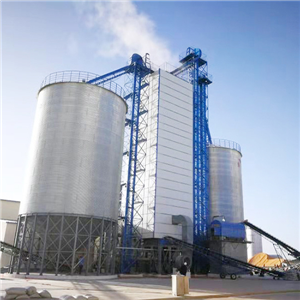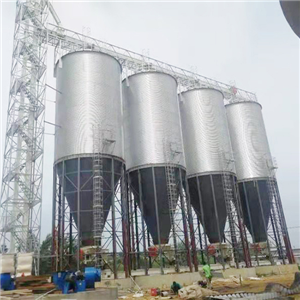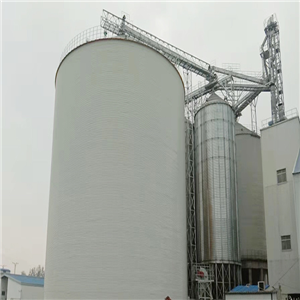Key Considerations for Large-Scale Grain Silo Construction: Safeguarding Safety and Quality
I. Pre-Construction Preparation: Geological Adaptation and Plan Refinement
In-Depth Geological Survey: Drilling is required to map soil layers within 30 meters of the surface, focusing on soft soil thickness, groundwater levels, and foundation bearing capacity. For silty clay or liquefiable soil, cement mixing piles (length ≥15m) or gravel cushions (thickness ≥1.5m) must be used for foundation reinforcement, ensuring a bearing capacity ≥200kPa to prevent uneven settlement.
Anti-Floating Design Enhancement: In areas with high groundwater tables (water table depth <2m), foundations should include anti-floating anchor bolts (minimum 4 per square meter, single bolt uplift capacity ≥150kN) or a "pile foundation + counterweight" combination to resist buoyancy during rainy seasons.
Dynamic Plan Adjustments: Construction details are refined based on grain types—for granular grains like corn and wheat, silo bottoms are sloped at 3°–5° for easy discharge; for high-moisture grains like rice, pre-reserved positions for ventilation pipes (spacing ≤1.5m) are required.
II. Structural Construction: Precision Control and Material Adaptation
- Precision in Steel Plate Installation:
For spiral-locked silos, verticality deviation per steel plate ring must be ≤1‰ (≤20mm for silos ≤20m in diameter), with adjacent plate gaps ≤1mm to ensure tight locking.
Welded joints use double-sided welding with a fillet height ≥6mm. Post-welding penetrant testing (PT) is mandatory to eliminate pores or slag inclusions that could compromise sealing.
The connection between the silo roof cone and cylinder uses a curved transition to reduce stress concentration. A 24-hour pressure test (pressure ≥0.2MPa) is conducted after welding to ensure no leakage.
- Material Adaptation to Scenarios:
Silo wall plates use low-alloy high-strength steel with yield strength ≥355MPa, with thickness increasing by height (8–10mm at the bottom, 4–6mm at the top), and undergo full hot-dip galvanization (zinc layer ≥350g/㎡).
Internal ladders and platforms use 304 stainless steel to prevent rust contamination of stored grains.
Weather-resistant silicone sealant (operating temperature -40℃~80℃) is applied to locked seams and bolt connections, forming a continuous seal to ensure airtightness (pressure decay rate ≤3%/h).
III. Safety Management: Targeted Control for High-Risk Links
- High-Altitude Work Protection:
Roof work zones are equipped with 1.2m-high guardrails (spacing ≤110mm), anti-slip patterned steel plates (thickness ≥3mm), and fall-arrest lifelines (load capacity ≥22kN).
Steel plate hoisting uses dual-crane lifting (single crane capacity ≥1.2 times the rated load), with lifting points at the plate’s center of gravity to prevent 晃动 during hoisting.
High-altitude work is halted during winds ≥6 级 or heavy rain; installed plates are temporarily secured (minimum 4 anchor points per ring).
- Confined Space Management:
Before entering silo interiors, ventilation is required for ≥30 minutes. Entry is permitted only after 4-in-1 gas detector confirmation (O₂ ≥19.5%, CO <24ppm).
Workers wear full-body harnesses with dual hooks; ground monitors maintain communication every 30 minutes—solo work is strictly prohibited.
Temporary lighting uses 24V safe voltage, with wires protected by conduits to prevent electric shock risks.
IV. Supporting Systems: Synchronized Construction and Functional Integration
Loading/Unloading Coordination: Hydraulic tilting platforms are positioned 1.5–2m from silo discharge ports, with a load capacity ≥60 tons. Independent pile foundations separate platforms from silo bases to avoid vibration interference.
Ventilation System Pre-Embedding: Bottom ventilation pipes (DN150 seamless steel) are installed at ≤3m intervals alongside the silo, with joints coated 3 times with epoxy coal tar for corrosion resistance.
Smart System Integration: Grain monitoring sensors (temperature, humidity, level) are pre-embedded during silo installation, with cables protected by galvanized steel conduits (burial depth ≥0.5m) to ensure stable data transmission to external control cabinets.
V. Acceptance Criteria: Comprehensive Performance Verification
Structural Safety: Silo verticality and roundness deviations ≤1%; 1.25x design wind pressure test (1-hour duration) shows no significant deformation.
Storage Adaptability: 80% capacity full-load test runs for 72 hours, with daily settlement ≤2mm; post-discharge inspections check for wall residues or deformation.
Safety Functionality: Emergency passages (width ≥0.8m) are unobstructed; fire systems (1 set of 8kg dry powder extinguishers per 500㎡) operate correctly; alarm response time ≤3 seconds.




